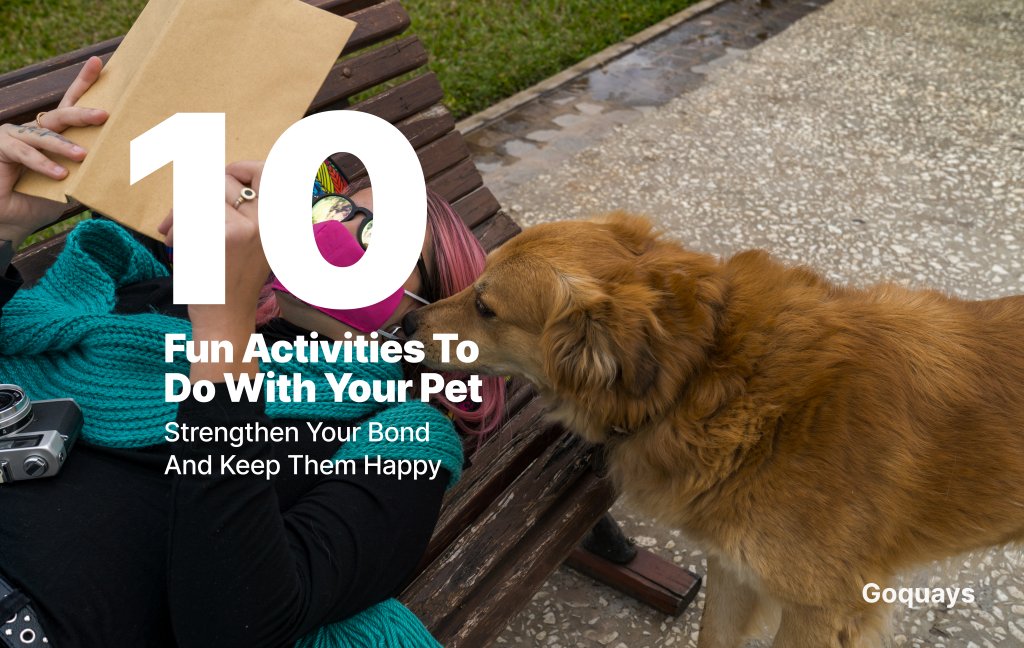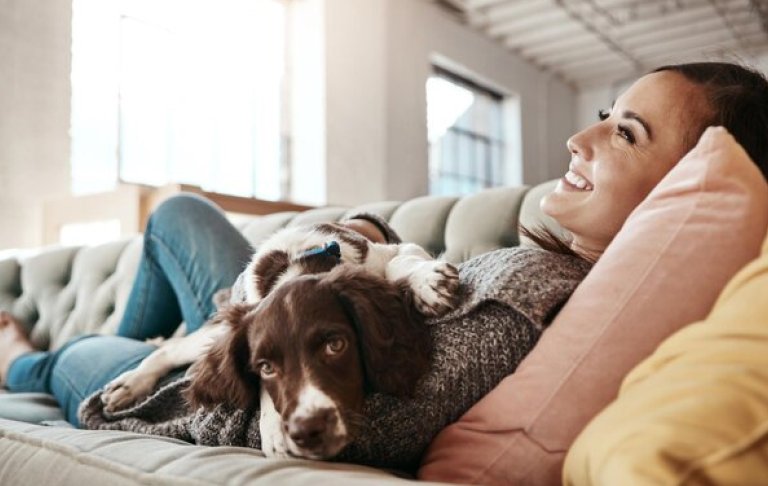Our pets are just like our families and spending quality time with them is one of the best ways to build trust, reduce anxiety and strengthen your bond. But with your limited free time, it can be hard to come up with various engaging ways to keep your pets happy and active.
In this post, we will share 10 fun activities you can do with your pet. These include outdoor adventures like hikes, and indoor games. These activities go beyond the typical “walk around the block because it will keep them physically healthy and mentally sharp. Plus, by staying active and engaged, your pet may even avoid certain health issues, making these activities more than just play—they are a key part of a healthy lifestyle.
At Quays, we are passionate about helping pet parents across the UK give their animals the best life possible.
Why fun activities are important for your pet's health and happiness
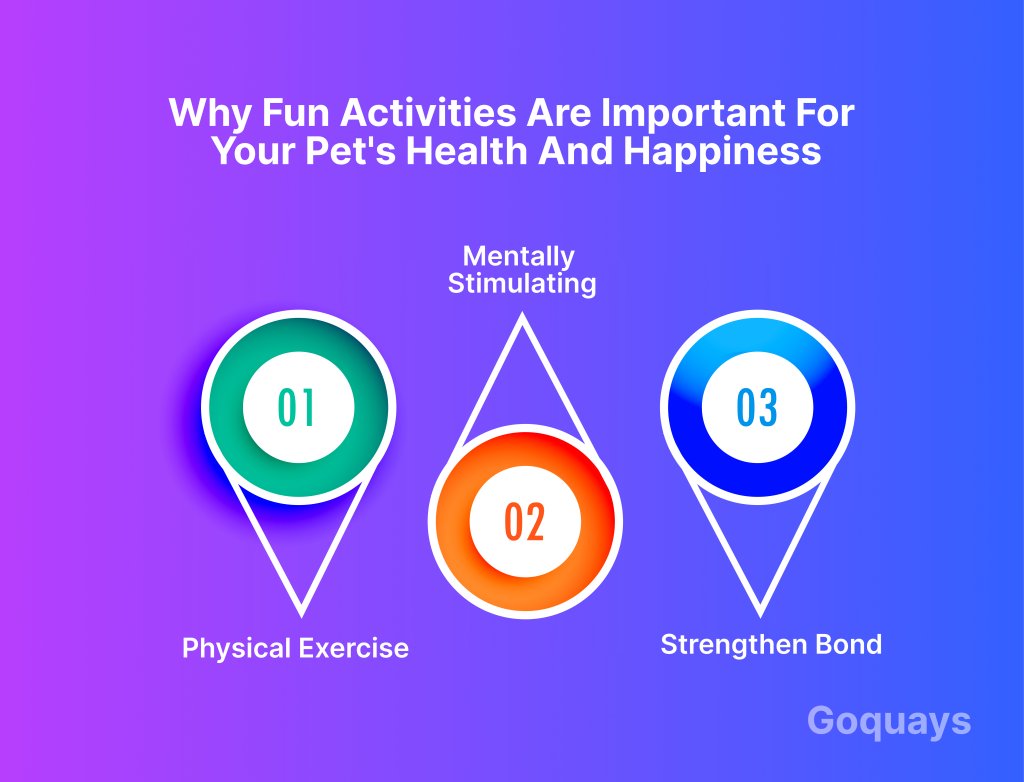
Pet needs regular mental and physical stimulation to stay happy and healthy, and engaging in fun activities plays in your pet’s overall well-being. Engaging in various activities helps your pet with;
- Physical exercise. Engaging in certain activities can be a form of physical exercise for your pets. Which can help them maintain a healthy weight, strengthen muscles and joints and reduce the risk of chronic conditions like obesity, arthritis, or heart disease. No matter the type of activity it is, having a regular movement keeps your dogs or cats agile.
- Mentally stimulating: Activities like puzzle toys or learning new tricks challenge your pet’s brain. It helps to sharpen their focus, reduce stress, and prevent boredom-related behaviours like chewing, scratching, or excessive meowing/barking.
Strengthen bond: By spending time together through play, training, or exploration nourish your relationship, making your pet feel secure, loved and emotionally balanced.
10 fun activities to do with your pets
Here are some activities you can do with your pets to strengthen your bond
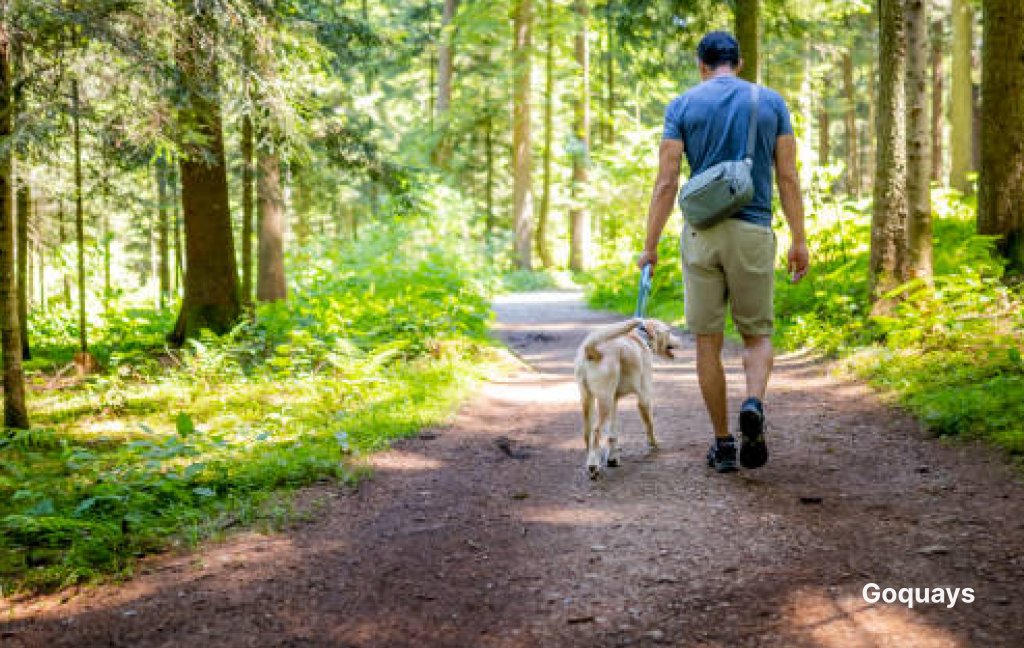
Go on nature walks or pet-friendly hikes
Exploring outdoor places is one of the most rewarding activities for you and your pet, especially if you have a dog. Going on nature walks or hikes stimulates your pet’s senses with new sights, sounds and smells, making it a mentally and physically rewarding experience.
For dogs, this is a perfect chance to burn off energy, stay fit and explore their natural instinct. Let them sniff around or climb over logs. It’s like fulfilling your dog’s fantasy. But be sure to keep them leashed unless you are in a designated off-lead area.
For cats, while hiking is less common with cats, it’s becoming more popular, especially with leashed trained felines. If your cat is comfortable on a harness and enjoys the outdoors, a gentle trail or enclosed garden area can be a great start.
When planning a walk or hike, look for pet-friendly trails across the UK, such as the Lake District, South Downs, or local woodlands and parks that allow animals. Don’t forget essentials like water, a portable bowl, poop bags, and treats.
Besides being fun, outdoor time helps improve your pet’s cardiovascular health, supports joint mobility, and reduces anxiety. For you, it’s also a great opportunity to unwind, exercise, and enjoy quality time together.
Explore engaging games like tug of war or fetch
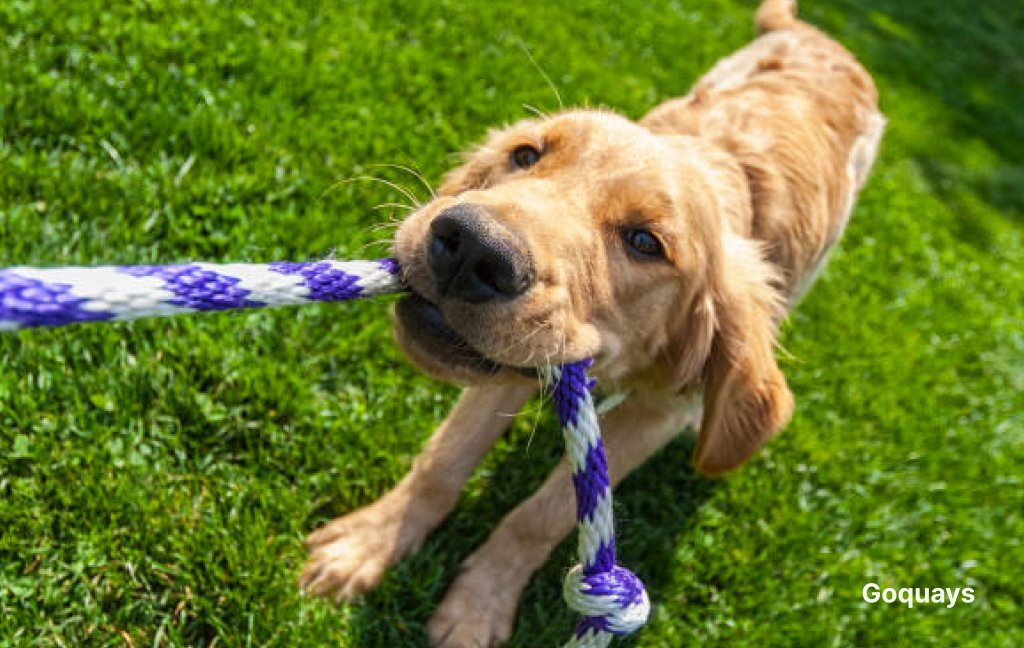
Engaging in activities that keep your pet happy doesn’t have to be elaborate. The best bonding moments could happen right in your living room or back garden. Playing games like tug of war or fetch are great ways to build trust, teach impulse control and help your pet burn off excess energy.
A tug-of-war game is especially effective for dogs. It engages their muscles, encourages focus, and taps into their natural play instincts. If you are worried that it may lead to an aggressive attitude from your pet, set rules like “drop it” or “stop it” to keep the game safe and respectful.
Fetch game, on the other hand, is a typical activity for both cats and dogs. You could use a ball, a frisbee, or a soft toy. Playing fetch is a fun way for your pets to practice their retrieving skills. These games are ideal for both indoor and outdoor play, depending on your space. They also teach your pet valuable commands like “come,” “drop,” and “stay.”
When playing with this, be mindful of your pet’s energy level to prevent overexertion or injury. And remember—Quays Pet Insurance can help cover unexpected vet visits for strained muscles or sprains, so the fun never has to end in worry.
Create a Diy obstacle course at home

Who says you need a fancy agility park to challenge your pet? For this activity, you can follow the rule of “use what you have to get what you want”. A DIY obstacle course is another great method to keep your pets physically active and mentally engaged from the comfort of your home.
Diy obstacle courses for dogs include weaving through chairs, jumping over broomsticks, crawling under tables, or walking along a line of cushions. It’s an excellent way to train focus, build confidence, and strengthen coordination. Start simple and gradually increase the difficulty as your dog gets the hang of it.
For cats, use cardboard boxes, tunnels, or low platforms to encourage jumping, climbing, and crawling. Cats love vertical spaces, so try stacking safe surfaces they can leap between. Incorporating treats or toys into the course can keep their attention and turn it into a playful challenge.
The beauty of a DIY obstacle course is that it’s customizable to your pet’s age, breed, and ability. Plus, it’s a great rainy-day activity that channels energy into positive behavior instead of destructive boredom.
Make sure each part of the course is safe and stable, and always supervise your pet while they are playing. If your furry friend has a medical condition or is recovering from injury, go easy and adapt the course as needed.
Try pet puzzle toys and treat games
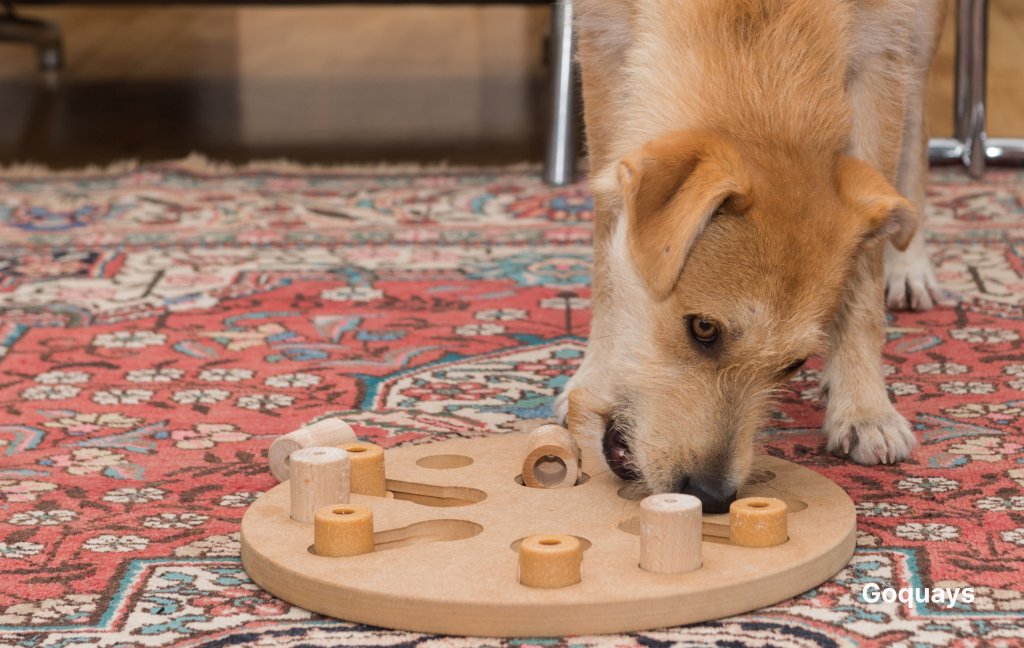
If you are also looking towards engaging your pet’s mind, not just their body, then puzzle toys and treat games are a must-try. This type of activity challenges your pet’s problem-solving skills. After playing the game, reward them with something they love (treats).
If you are a dog parent, use tools like puzzle feeders, snuffle mats, and treat-dispensing toys to stimulate your dog’s brain and encourage slower eating. Tease your dog by having them think, paw, nudge or sniff out the reward. Doing this prevents boredom and destructive behaviours, it can also reduce anxiety by giving them a “job” to focus on.
For cat parent, use this game to explore their hunting instinct. Use toys that make them chase, bat, or work for treats, like puzzle boxes or hide-and-seek treat trays. You can even DIY a puzzle game by cutting holes in a cardboard box and hiding treats inside.
These mental challenges are especially helpful for indoor pets or on days when outdoor activity isn’t possible. They improve cognitive function, encourage independence, and offer a safe outlet for natural behaviours like sniffing, foraging, or stalking.
Always supervise the first few play sessions to ensure the toys are safe and appropriate for your pet’s size and play style. If you notice signs of frustration, take a break or simplify the task.
Schedule a pet Spa day

A pet spa day is a soothing way to care for your furry friend and, at the same time, strengthen your parent-pet bond. If you are wondering, a pet spa day doesn’t have to be necessarily elaborate, it could be a Diy grooming session at home or a visit to a professional groomer.
For a Diy spa day, make your pet feel special by setting the mood: a calm, quiet space, soft towels, pet-friendly shampoo, and lots of treats for positive reinforcement. If you are grooming a dog, include a gentle bath, brushing, nail trimming, ear cleaning, and maybe a massage to relax those muscles, especially after a long walk or hike.
On the other hand, if it’s a cat, use a soft brush to remove loose fur and prevent hairballs, especially for long-haired breeds. If your cat enjoys water (rare, but not impossible!), you can attempt a light rinse. Otherwise, stick to dry grooming methods and focus on areas they can’t clean well themselves.
Grooming not only improves your pet’s appearance and hygiene but also helps you check for any unusual signs like bumps, fleas, ticks, or skin irritations that may require a vet’s attention. Most importantly, this quiet, hands-on time promotes trust and emotional connection. Your pet learns to associate grooming with love and care, making them more relaxed and cooperative over time.
Host a pet playdate
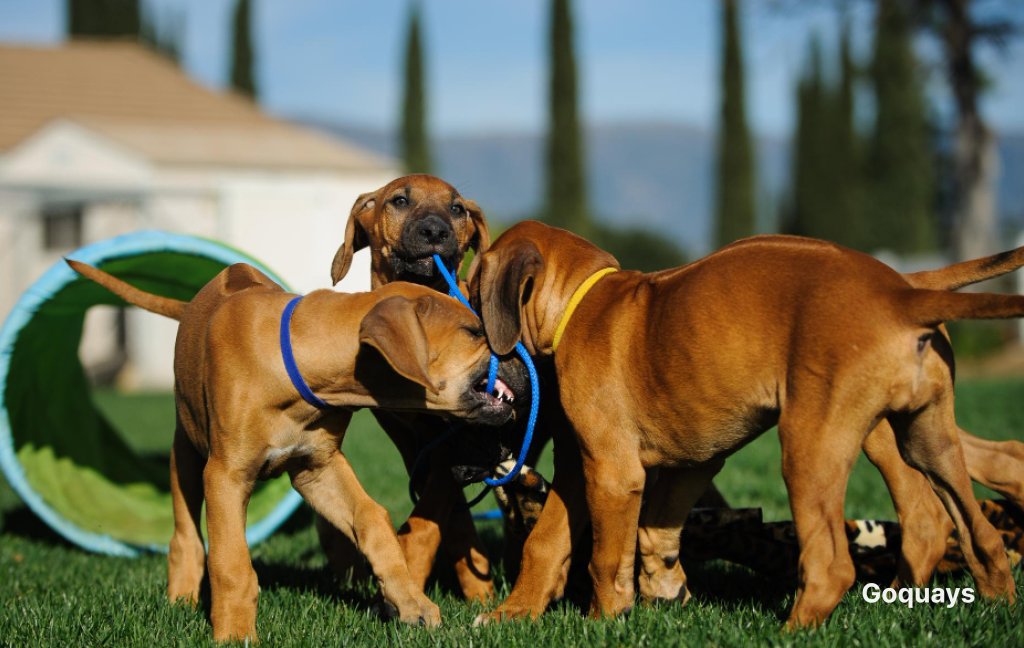
Just like humans, pets also thrive on social interactions, not only with their owners but also with other animals like them. And by hosting a playdate, it’s a fun way to help them build positive social skills. If you have a dog, you could arrange a meeting between your dog and maybe a friend’s pup at a dog-friendly park or beach.
Typically, dogs are social animals by nature, and playdates help them burn energy, learn boundaries, and boost their confidence around other dogs and people. A well-socialised dog is generally less anxious, more obedient, and more adaptable in public spaces.
For cats, while they are more of a lone animal, they can also benefit from socialization, especially if they are indoor cats or part of a multi-cat household. A calm, supervised visit with another cat or a short outdoor session in a secure garden can offer new scents, sights, and experiences that challenge their curiosity.
Not all pets warm up to strangers immediately, so it’s essential to match temperaments and start slow. Introduce them in neutral spaces, keep initial interactions short, and reward good behaviour with treats or praise. And of course, stay attentive to body language if your pet seems overwhelmed or uncomfortable; it’s okay to pause and try again another time.
Social outings are not just great for your pet—they are also a chance for pet parents to connect, share tips, and maybe even discover new pet-friendly venues in your area. Just be sure your pet is up-to-date on vaccinations, flea treatments and has proper ID tags.
Teach your pet a new command
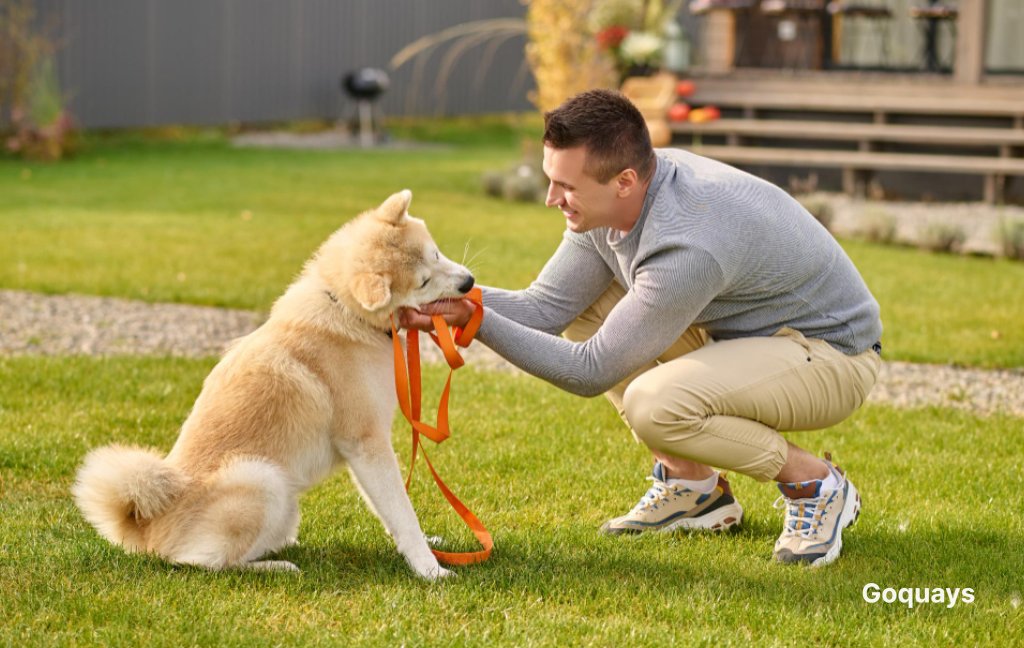
Training your pet is not just for obedience; it also benefits your pet by mentally stimulating them and deepening the bond between you and your pet. For dogs, basic commands like “sit,” “stay,” or “come” are great starting points. Once mastered, you can move on to more playful tricks like “spin,” “play dead,” or even agility training. Training encourages focus, builds confidence, and gives your dog a sense of purpose.
Cats are usually underestimated in the training department, but they are responsive to these commands than you could ever think. You could opt for clicker training for cats as they work well when teaching cats commands–compared to dogs, you have to be more patient with cats to understand their rhythm and get them to understand the command.
Keep training sessions short and positive—about 5–10 minutes at a time. Use rewards like treats, praise, or play to reinforce the behaviour you want, and always end on a high note. This way, your pet associates training with fun and success.
Trick training also sharpens your pet’s memory and reduces problem behaviours caused by boredom or excess energy. If your pet struggles or you notice discomfort during training, take a step back. Sometimes, underlying health issues can make certain actions painful.
Water fun
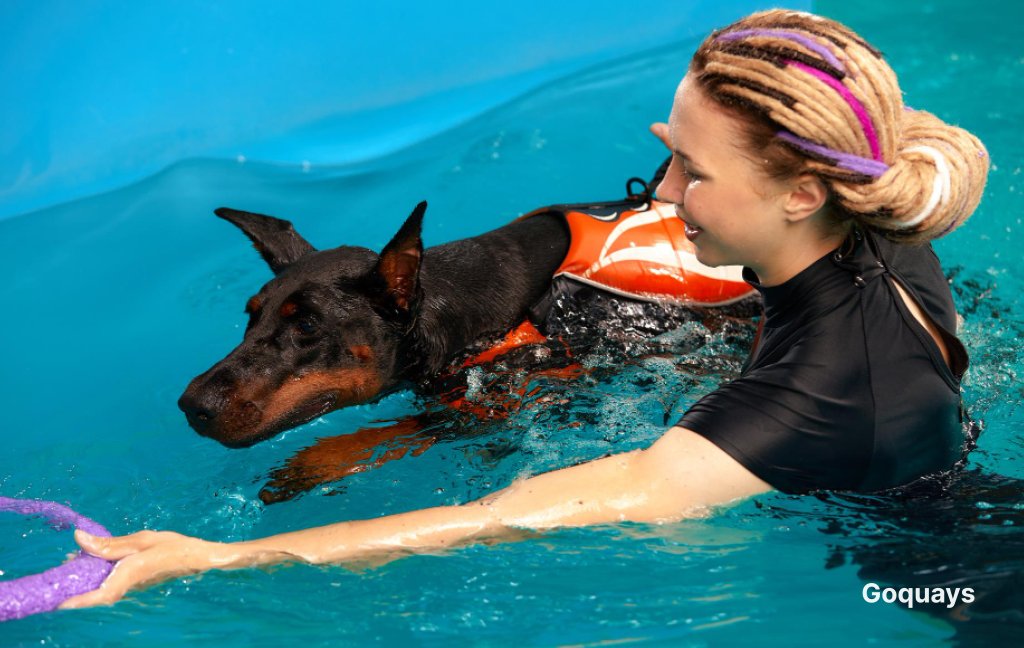
Not every pet is a natural-born swimmer, but when the weather warms up, a splash session can be just the thing to cool off and have a blast, especially for water-loving dog breeds like Labradors, Spaniels, and Retrievers. Even some adventurous cats are curious about a bit of supervised water play.
Try pet paddling at home
You can DIY your pet paddle at home by setting up a small, shallow paddling pool in your garden or balcony for a refreshing play session. Add floating toys or treats to make it a game. It’s a low-cost way to help your dog stay cool and active, and you’d be surprised how many cats enjoy dipping their paws when introduced gently.
Plan a beach day
There are various dog-friendly beaches in the UK, like Perranporth in Cornwall, West Wittering in Sussex, or Formby Beach in Merseyside. Bring along a frisbee, plenty of water, an umbrella for shade, and a towel for shake-off.
Safety tip: Always supervise your pet around water and use non-slip mats around the pool to avoid injuries.
Explore pet-friendly cafes
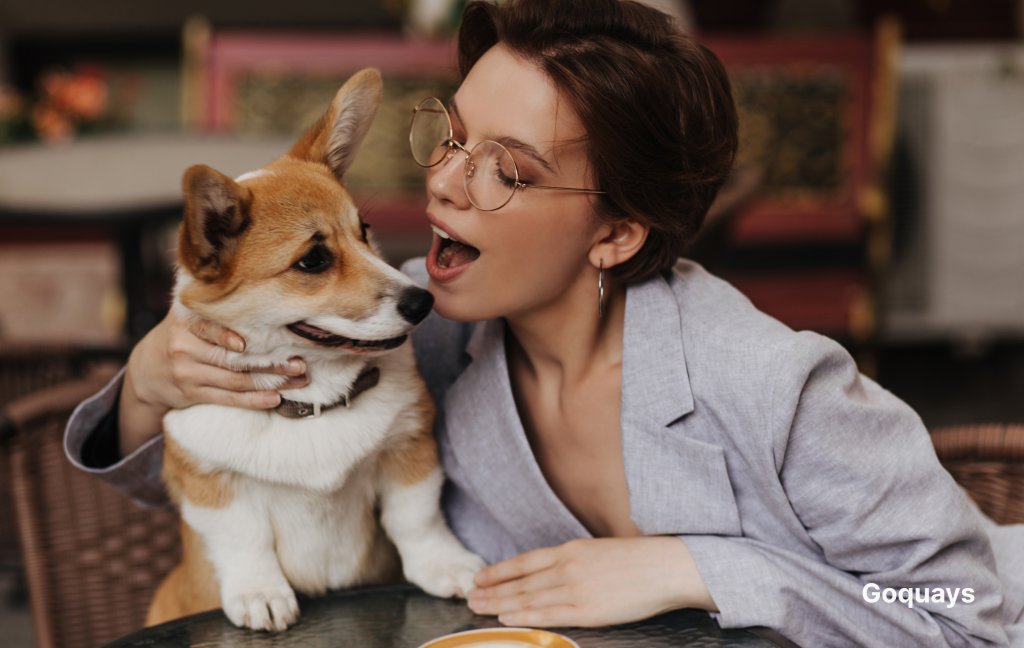
One of the joys of being a pet parent in the UK is the growing number of pet-friendly cafes and shops that welcome your pets with no bias. Outings like this with your pets create opportunities to create shared memories with your pets.
For dog owners, this can be quite rewarding as many cafés now offer outdoor seating and even dog-specific menus with “puppuccinos,” dog biscuits, or gourmet treats. Some go a step further by providing water bowls, cosy resting areas, and even doggy brunch events. These relaxed settings are great for dogs to soak in new smells, observe passersby, and engage calmly with strangers and other dogs.
You can explore cafes like The Dog House Café in Manchester or Paws for Coffee in London ,which have become community hubs for dog lovers. Attending a “Yappy Hour” or a dog café event can be an exciting outing not just for your pet, but for you, too.
If you have a cat, outings may require a bit more preparation. While most cats prefer the comfort of home, confident or leash-trained cats may enjoy short visits to quiet, pet-friendly shops or cat-focused boutiques that stock treats, toys, and accessories. Even just allowing your cat to explore a pet supply store in a secure carrier or on a leash can be a fun sensory experience—new smells, textures, and sights to take in.
Here’s how to prepare for a successful visit:
- Start small: Try local spots during quiet hours for a calmer experience.
- Pack essentials: Water, treats, waste bags, wipes, and a calming toy or blanket.
- Check policies: Not all cafés or shops allow pets indoors, so always call ahead or check signage.
Reward good behaviour: Treats and praise help reinforce positive associations with these outings.
Watch pet TV or listen to pet-friendly music
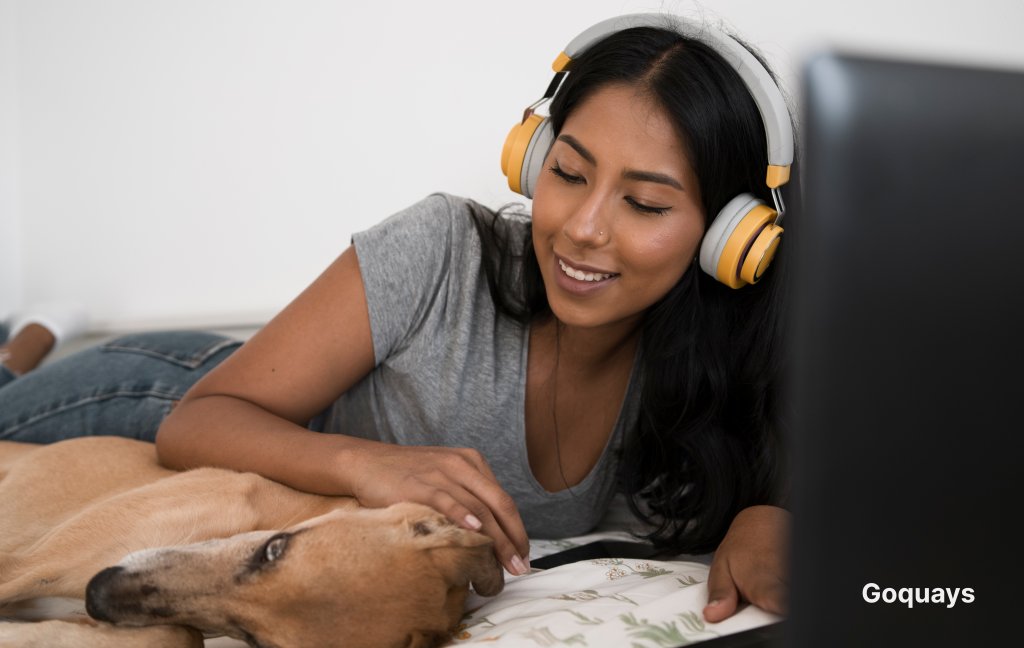
This is another great way to engage your furry friend’ senses, help them relax and unwind after a play day.
For dogs, Pet TV shows often feature nature scenes, animals moving slowly across the screen, or other dogs playing and running—something that sparks curiosity without overwhelming them. Some streaming platforms even offer content specifically created for dogs, designed to reduce anxiety and boredom.
Cats, too, are captivated by motion. This includes flickering birds, scurrying mice, or fluttering insects that can grab their attention. These videos tap into their natural hunting instincts and keep them mentally stimulated, especially during solo hours.
Pair that with pet-calming music like classical, reggae, or specially designed frequencies, and you’ve got a spa-like setting for your pet. Studies have shown that soothing music can help reduce stress in dogs and cats, particularly during thunderstorms, fireworks or when they’re home alone.
To try this activity at home:
- Stream pet-specific content on YouTube or pet streaming platforms
- Play calming playlists on Spotify (yes, there are pet playlists)
- Create a cosy viewing or listening space with their bed, blanket, or toys
- Observe how your pet reacts. Some may be glued to the screen, others may just enjoy the background sounds
It’s a perfect low-energy activity for rainy days, lazy evenings, or senior pets who prefer comfort over cardio. Just keep screen time balanced with active play to support their overall well-being.
Tips to make every activity safe and enjoyable
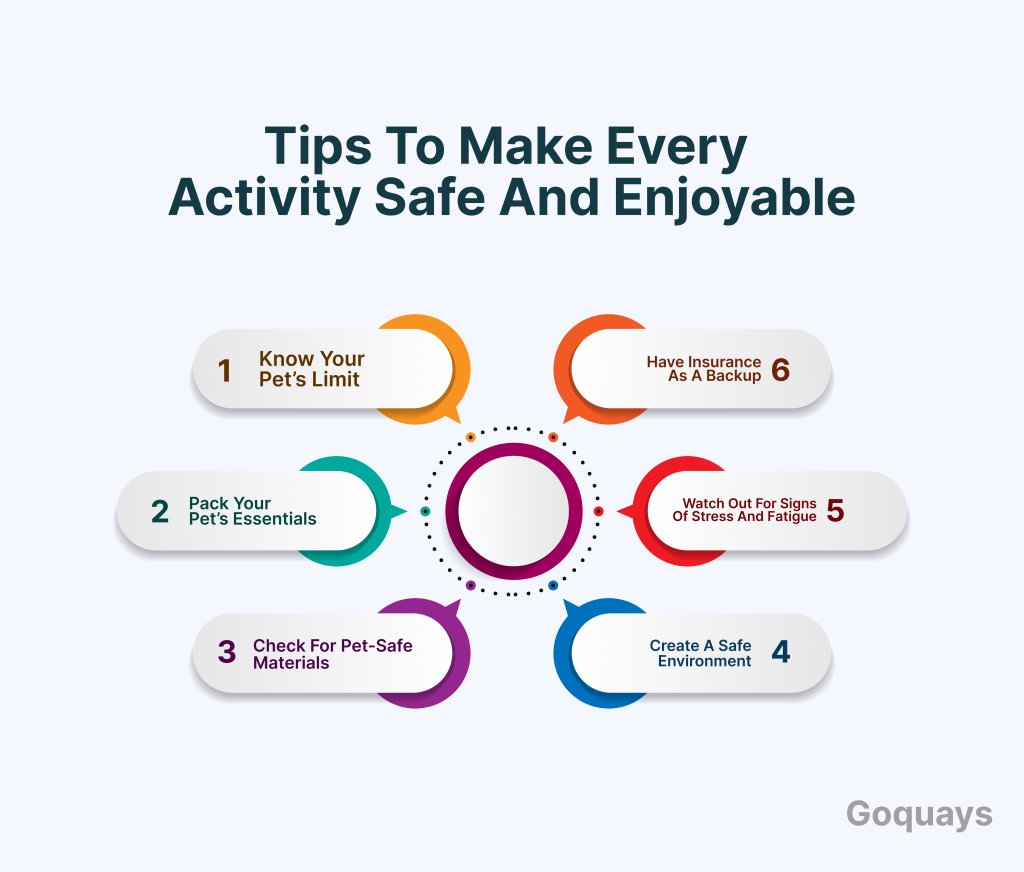
While your main goal as a pet parent is to create an enjoyable atmosphere for your furry companion, safety should always come first when planning any activities for your pet.
Here are some tips you should keep in mind;
- Know your pet’s limit
Every pet is different. Some are full of energy, while others are more laid-back. Consider your pet’s:
- Age and breed (e.g., brachycephalic dogs like Pugs or Persian cats tire easily)
- Health condition (older pets or pets with arthritis may need gentler play)
- Temperament (shy or reactive pets may get stressed in busy environments)
Tailor activities to suit their personality and physical capabilities. Forcing high-energy games on a senior cat or taking a nervous dog to a loud café can backfire.
- Pack your pet’s essentials
For outdoor or away-from-home activities, carry a pet essentials kit, including:
- Fresh water and a portable bowl
- Healthy treats or snacks
- Poop bags or litter disposal items
- Pet-safe wipes for cleaning paws or minor messes
- A collar with ID tags and a leash or harness
Being prepared helps avoid discomfort, hunger, or hygiene issues that could cut your activity short.
- Check for pet-safe materials
If you are doing a craft or Diy activity, ensure you are using non-toxic and pet-safe materials. For outdoor or away-from-home activities, carry a pet essentials kit, including:
- Fresh water and a portable bowl
- Healthy treats or snacks
- Poop bags or litter disposal items
- Pet-safe wipes for cleaning paws or minor messes
- A collar with ID tags and a leash or harness
Being prepared helps avoid discomfort, hunger, or hygiene issues that could cut your activity short.
- Create a safe environment
Whether it’s an indoor or outdoor activity, ensure it is pet-proofed
- Remove breakable or hazardous objects from play areas
- Ensure your garden is secure and escape-proof
- Supervise closely when introducing your pet to new toys, areas, or animals
- Be mindful of weather conditions—avoid mid-day heat, rain, or icy conditions that could put your pet at risk
For indoor games, use non-slip rugs and avoid high surfaces that could lead to falls.
- Watch out for signs of stress and fatigue
Your pet may not show any discomfort in an obvious way, but look out for;
- Panting, drooling, or excessive yawning
- Hiding, trembling, or tail tucking
- Pacing or avoiding eye contact
- Sudden aggression or excessive meowing/barking
If you notice any of these signs, pause the activity, offer a quiet space, and comfort your pet. Never force them to continue if they seem uneasy.
- Have insurance as a backup
Irrespective of putting precautions in place, the accident could still occur. This includes: scratches, minor injuries, allergic reactions, or unexpected vet needs. That’s where Quays Pet Insurance comes in. With coverage tailored for UK pet owners, you can focus on having fun while we handle the unexpected.
How does pet insurance complement an active lifestyle

An adventurous lifestyle can sometimes come with unexpected risks—scraped paws, digestive issues from a new treat, sprains from too much play, or even allergic reactions from the outdoors.
That’s where pet insurance steps in as your trusted safety net.
- Coverage for unexpected accidents
Whether it’s a minor injury from a hike or a tumble during a game of fetch, active pets are more prone to bumps and bruises. Pet insurance helps cover the cost of vet visits, medications, and treatments, so you can address health concerns early without worrying about how much it will set you back financially.
For example:
- A torn claw during a nature walk
- Muscle strain from overexertion during a play session
- Insect bites or minor wounds fromthe garden
These are common occurrences that can quickly become expensive if left untreated. With the right plan, you won’t need to hesitate before getting your pet the care they need.
- Support for chronic conditions resulting from overexertion
Sometimes, regular high-energy activities can lead to long-term conditions like arthritis, joint inflammation, or repetitive strain injuries, especially in older pets or certain breeds. Pet insurance often includes coverage for ongoing treatments, physiotherapy, or vet-recommended supplements to help manage chronic issues without cutting down on your pet’s quality of life.
- Peace of mind for explorers
If your pet loves to explore—whether it’s a café, hiking trail, beach, or pet-friendly event—there is always a small chance of exposure to new risks like bacteria, contaminated water, unfamiliar animals, or allergic reactions. Insurance gives you peace of mind that if something goes wrong, you are covered.
For example, coverage could apply to:
- Gastrointestinal issues from eating something off the ground
- Flea or tick bites from outdoor play
- Emergency care if your pet reacts to something unknown
- Encouraging proactive pet parenting
Knowing you are financially protected means you are more likely to be proactive about your pet’s health. You are less likely to delay vet visits, skip treatments, or hesitate to ask questions about strange symptoms. This encourages a more attentive and preventative approach, essential for a long, happy, and healthy pet life.
Conclusion
Spending quality time with your pet isn’t just a fun way to pass the time—it’s also a means of investing in their overall well-being and your relationship with them. The best part of incorporating fun activities into your pet’s routine is that it doesn’t have to be complicated.
It’s about being intentional about your pet, making time for them between your busy schedule to make memories, deepen connections and also make them happy. And while play is important, peace of mind is essential. That’s where having reliable pet insurance comes in.
With Quays Pet Insurance, you can explore life with your pets confidently, knowing that you are covered if the unexpected happens. From minor bumps to more serious health concerns, we are here to help you protect what matters most—your pet’s health and your time together.
So go ahead: plan that hiking trip, test out a puzzle toy, or discover a new pet-friendly café. Make it fun, make it safe, and most importantly, make it meaningful.

